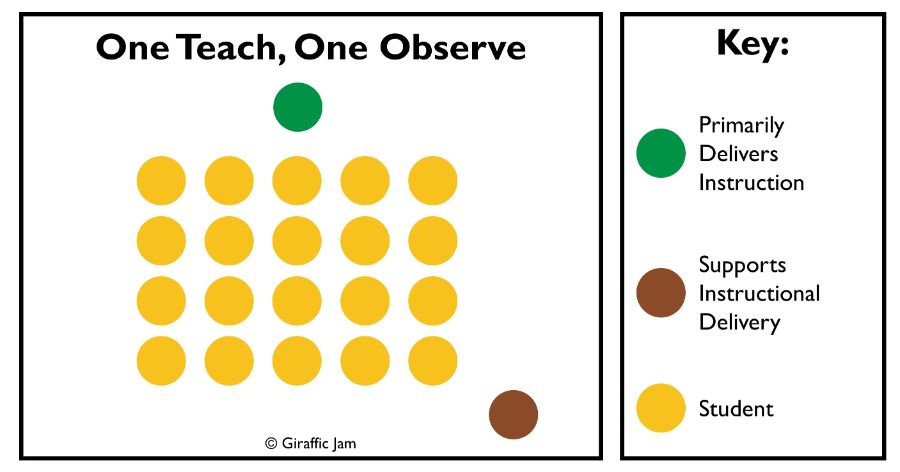
One teach, One observe is a great co-teaching strategy to try. It’s a perfect strategy to try if you need to gather data about your students. One teach, one observe is when one adult delivers the instruction while the other adult collects data.
There are six different types of co-teaching. No matter which of the types of co-teaching you use, you and your co-teacher can be highly effective instructors when you work together to plan and deliver lessons. Co-teaching works, because it involves two adults actively working together to provide instruction.
Simply put, co-teaching is when two adults work together to teach a lesson. Notice, I say ‘adults’ not teachers. Why? It’s simple really, it could be two teachers. Or, it could be an intern and a teacher. Or, a substitute and a teacher. Or, an instructional assistant and a teacher. Or, a substitute and an instructional assistant. Or…..
Well, I guess you get where I’m going with this. However, old habits die hard so throughout this post you’ll see me refer to the adults as ‘teachers’. Just don’t limit yourself to thinking of teachers only in the traditional sense!
Don’t be limited to thinking that co-teaching is always a gen ed teacher and a special education teacher. It can be, but it doesn’t have to be. If you think outside the box, you might find that you have more opportunities for co-teaching than you realize!
One teach, one observe co-teaching is when one teacher leads the instruction and the other teacher collects information on the students. The observing teacher should know specifically what they are looking for and have a way to collect and gather the data. They might consider things like notebooks, digital records, or post it notes to keep track of students and their progress. Data could be collected on academic progress as well as behavioral or social concerns.

In one teach one observe teaching, one teacher leads the instruction while the other collects specific data and information about student progress and needs.
Data is easily collected and collected in a ‘natural setting’. We all know, when admin walks in suddenly students are doing things they’ve never done before (for better, or worse). But, with this strategy, the observer is someone familiar with the classroom so students should be acting ‘normally’. When one observes, they are able to gather specific data that will be crucial to developing the next lesson and writing IEPs or report cards. Tons of information can be gathered, because the person observing doesn’t have to worry about what they are saying or doing. They can just observe!
The observer has to be someone who can…well, observe. The observer should be someone who can look at a situation and notice many small details.
Using this co-teaching strategy too often can result in students seeing one adult as the ‘real teacher’ and one as the ‘helper’. And, that can cause some difficulty with classroom management and respect from students. This strategy should only be used when there is a specific purpose in mind – for instance, a specific piece of data to be collected.
Co-Teaching can be hard. If you’re looking for more information, check out this blog post to read some of my favorite tips and tricks for getting the ball rolling!
Co-teaching is an effective tool for reaching all of your learners. It allows both teachers the opportunity to see students and their progress. When you use parallel teaching as your co-teaching method, it gives the students the chance to see the lesson in a smaller group setting. Did you know there are five other types of co-teaching? Check them out here!